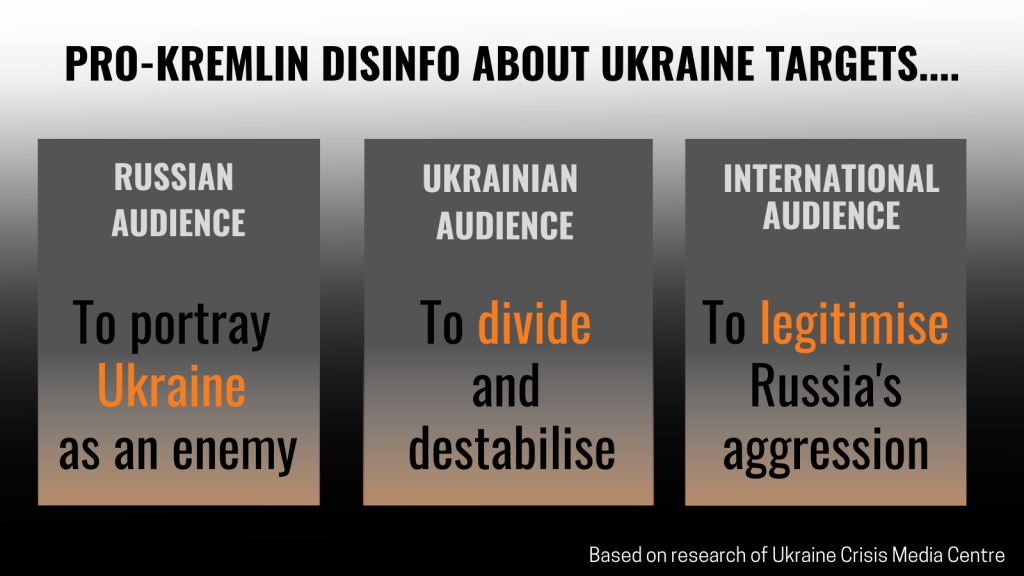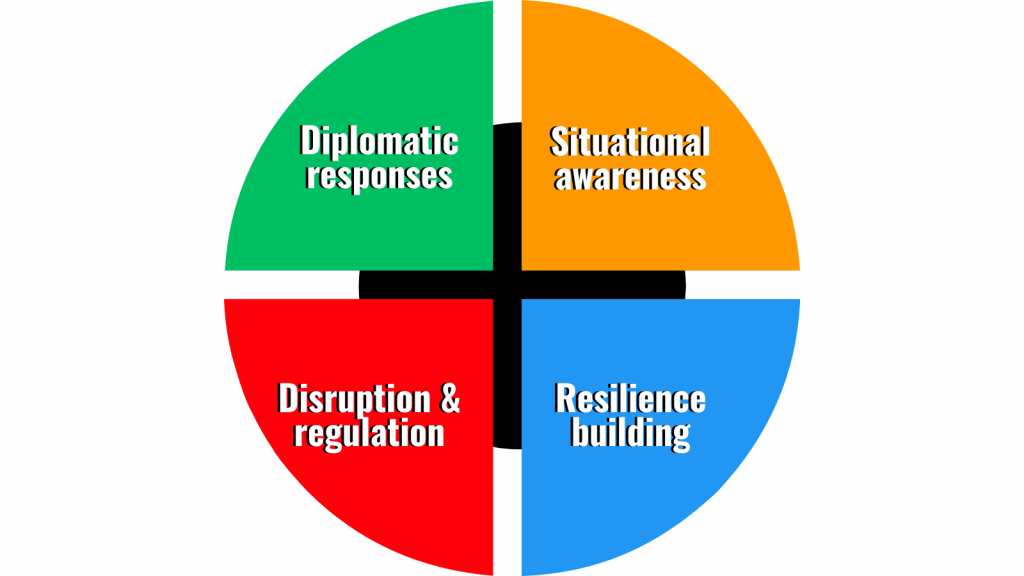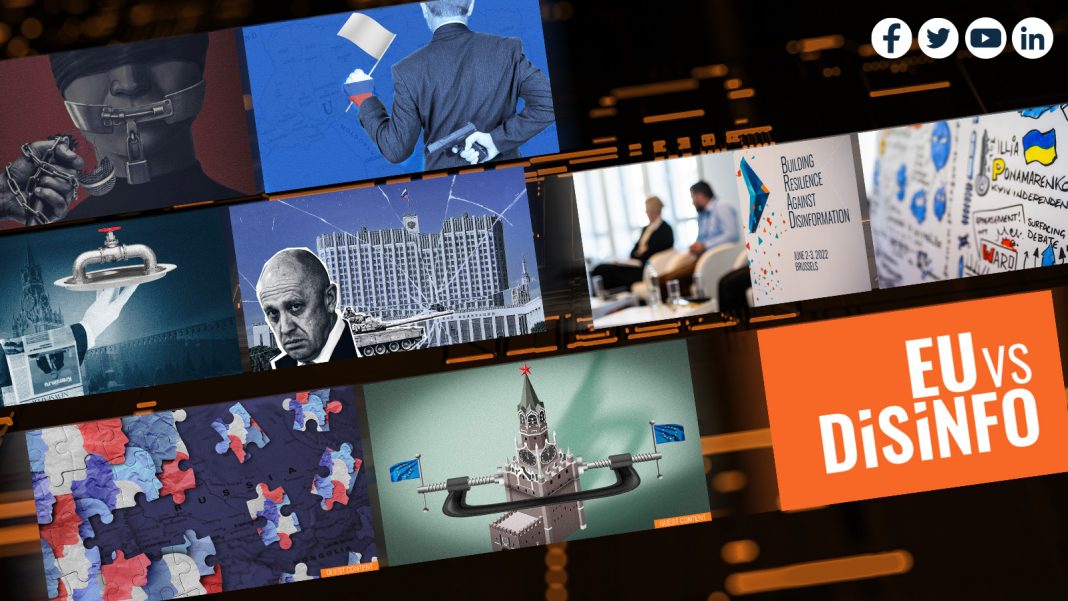By EUvsDisinfo
This is an updated and expanded version of an EUvsDisinfo article first published in April 2020. You can read the original text here.
With this article, we again invite our readers on a behind-the-scenes tour of the EUvsDisinfo website. We go through some key moments of our history in an ever-changing threat landscape, starting from Russia’s aggression against Ukraine in 2014 and the subsequent decision by EU leaders to set up the East StratCom Task Force. We reflect on the lessons learned fighting the COVID-19 pandemic and especially its accompanying ‘infodemic’ as well as our efforts to counter Russian disinformation and information manipulation in the context of the Kremlin’s brutal, full-scale invasion of Ukraine that began in February 2022. Ultimately, the evolution of EUvsDisinfo is part of a larger story of the European Union strengthening its response to foreign information manipulation and interference (FIMI) threats.
A unique mandate
On 19 and 20 March 2015, the leaders of the then 28 EU countries gathered in Brussels. One of the decisions the participants in this summit put down on paper was the following:
The European Council stressed the need to challenge Russia’s ongoing disinformation campaigns and invited the High Representative, in cooperation with Member States and EU institutions, to prepare by June an action plan on strategic communication. The establishment of a communication team is a first step in this regard.
With a unanimous decision coming from the highest level of decision-making in the European Union that clearly called out Russia as a source of disinformation, the 28 heads of state and government gave a strong and unique mandate to the future work of what became the East StratCom Task Force. In the years since, the EU has reaffirmed and reinforced this mandate.
A team of experts was formed in the Strategic Communication and Information Analysis Division of the EEAS, the EU’s diplomatic service. You can learn more about the activities of the EEAS Strategic Communication, Task Forces and Information Analysis Division here.
Ukraine – the main target of Russia’s disinformation
Before looking into how this political mandate was translated into practice, it is worth recalling the situation in the eastern part of the European continent at that time.
In 2014 – the year before the team was set up – a European country had for the first time since the Second World War used military force to attack and grab land from a neighbour: Russia illegally annexed the Ukrainian peninsula of Crimea. Russia-backed armed separatist groups had also took control over parts of eastern Ukraine, starting the war that culminated in Russia’s full-scale invasion eight years later. In July 2014, Russia-backed separatists using a Russian missile shot down Malaysia Airlines Flight MH17 with 298 people on board – among them 80 children and 196 Dutch nationals.
An overwhelming disinformation campaign accompanied these events. Outright lies, spread straight from the Kremlin and supported by a vast disinformation ecosystem, played a central role in this campaign. In effect, the Kremlin turned information manipulation into a geopolitical weapon. Its goal, first and foremost, was to undermine and destabilise Ukraine by sowing doubt and confusion both on the ground and in the eyes of the international community.

Image based on 2021 EUvsDisinfo article: The Kremlin’s Main Target of Disinformation
More recently we have seen how pro-Kremlin disinformation has paved the way for Russia’s full-scale invasion of Ukraine, (see also here) rallying domestic support for the war and increasingly, calling for and justifying atrocities in Ukraine. At the same time, the pro-Kremlin disinformation ecosystem is reaching further into global audiences, exploiting topics such as food and energy security to undermine global support for Ukraine.
Responses to disinformation: EUvsDisinfo awareness raising campaigns
EUvsDisinfo is one of the answers to a fundamental question linked to the political mandate given by EU leaders: how can one challenge disinformation?
The EUvsDisinfo website and social media accounts are based on the premise that raising awareness is a necessary (but not the only[1]) element of countering disinformation. Being aware of the fact that not only Russia but also other foreign actors are wielding disinformation as a weapon, recognizing the main disinformation tropes, knowing the most common manipulation tactics and techniques, understanding the basic principles of fact-checking and verifying information (especially online), makes us more resilient!
EUvsDisinfo aims to provide basic tools to help build this resilience. Our content is available in multiple languages, including Ukrainian, Romanian, Russian, German, Polish, French, Italian, Spanish, Georgian, Armenian, Azerbaijani, and in some cases Chinese.
Central among these tools is EUvsDisinfo’s database, a publicly available and growing repository of more than 15,000 examples of pro-Kremlin disinformation. Database entries have been collected since late 2015. Each of them represents an individual example of pro-Kremlin disinformation– i.e. disinformation from outlets that can be linked to the Kremlin’s disinformation ecosystem, based on their financing, subject to state-control, or manipulative behaviour online. While the database cannot be used to quantify disinformation, it allows us to follow trends and topics that the Kremlin instrumentalises for information manipulation purposes and to identify main disinformation tropes.
For example, the EUvsDisinfo database shows that the baseless accusation of Ukraine being a “Nazi state” which the Kremlin used as the main justification for the full-scale invasion in 2022, has been a recurring pro-Kremlin disinformation narrative. The database contains close to 600 entries, dating back to 2015, which specifically accuse Ukraine of being a “Nazi/Fascist” state. Indeed, the narrative of “Nazis” surrounding Russia is one the key pro-Kremlin disinformation narratives, along with ‘The Elites vs the People’, ‘Threatened Values’, ‘Lost Sovereignty’, ‘Imminent Collapse’ and ‘Hahaganda’. You can learn more about them on the EUvsDisinfo website.
Based on our continuous monitoring of the pro-Kremlin disinformation ecosystem, EUvsDisinfo offers a number of publicly available products. They include:
Disinfo Review, a weekly newsletter presenting the latest trends in pro-Kremlin disinformation. You can read it online every Thursday morning or subscribe here.
The LEARN section, a site that provides key tools to understand and respond to disinformation. Since its launch in 2015, EUvsDisinfo has produced close to 4,000 pieces of content – articles, interviews, and essays in 14 different languages. There is a lot of information out there! LEARN is a one-stop resource that helps to understand the key definitions and mechanics of disinformation. It also provides examples of responses and external resources to learn more.
Guest content. Challenging disinformation requires a whole-of-society approach, meaning that no single institution or organisation can do it alone. And there are many fact-checkers, journalists, data analysts, think tanks, and activists whose work helps to tackle the threat and, step by step, is making our society more resilient. Guest content on EUvsDisinfo features some examples of this important work, from a Ukrainian researcher investigating how Russia is adapting its information manipulation tactics to wage its brutal war, to an international think tank looking at how the Chinese Communist Party is using information manipulation to shape international perceptions about Beijing’s policies in Xinjiang.
In addition, you can find dedicated topical sections where we look at issues such as election interference or analyse disinformation targeting specifically the Eastern Partnership initiative, democratic forces in Belarus and Ukraine, and other subjects.
Studies and Reports is a unique collection encompassing a wide range of third-party studies, articles, and reports relating to pro-Kremlin disinformation. Whether you want to explore a general introduction, to learn about the Kremlin’s attempts to interfere in elections, or to investigate how one single false message is spread via a wide network of websites, this is the place to start.
An Evolving Threat and Improved Responses
When it comes to disinformation, the threat landscape is continuously evolving. So must our understanding of the threat and our responses, if we want to stay ahead.
China – Another Disinformation Actor
It is clear that Russia is not the only foreign actor that is engaging in disinformation and information manipulation with (geo)political goals.
In the Joint Communication on Tackling Covid-19 Disinformation, released at the height of the infodemic in June 2020, the EU clearly stated that:
certain third countries, in particular Russia and China, have engaged in targeted influence operations and disinformation campaigns around COVID-19 in the EU, its neighbourhood and globally, seeking to undermine democratic debate and exacerbate social polarisation, and improve their own image in the COVID-19 context.
China has emerged as an information manipulation and disinformation actor with a diverse arsenal of tactics, although its methods are different from those of Russia. Nonetheless, EUvsDisinfo has documented how certain disinformation narratives have converged between pro-Kremlin and Chinese disinformation networks.
Chinese state-controlled media and official social media channels have amplified selected pro-Kremlin conspiracy narratives. Notably, among them is a conspiracy about “American-funded secret labs” which allegedly surround Russia and where supposedly biological weapons are produced. This is an old pro-Kremlin disinformation trope that was revived during the pandemic and more recently, as another attempt of the Kremlin to justify its invasion of Ukraine. Russia’s war in Ukraine has provided further evidence of China’s and Russia’s convergence in the information environment, when Chinese actors also amplified disinformation narratives portraying Ukraine as a “Nazi” state.
The pro-Kremlin information manipulation ecosystem also eagerly amplified China’s statements that absolve Russia of any responsibility for the aggression against Ukraine, something we’ve observed since the early days of the war.
These and other examples of convergence between Russia’s and China’s disinformation activities are covered in a dedicated section on China on EUvsDisinfo (with some EUvsDisinfo texts also available in Chinese).
New Terminology and Emphasis on Data
Much has been said and written about internet trolls (entire factories of them!) and bots, as amplifiers and spreaders of disinformation. Arguably, throughout the years we might have gotten better at detecting them, or at least more aware. But these days one must also consider the risks generative AI and similar technologies might bring, including proliferation of disinformation.
Clearly, deceit and manipulation are not limited to false information or misleading content. Disinformation messages can be mind-numbingly repetitive. However, manipulative behaviour, in particular online, continues to evolve. That is why we must look beyond the misleading and/or false content to how disinformation actors behave.
The direction that our work takes very much depends on the definitions and approaches we use. That is why we increasingly frame disinformation as a part of broader manipulative activity – foreign information manipulation and interference, or FIMI.
Foreign information manipulation and interference refers to a pattern of manipulative behaviour in the information domain that threatens values, procedures and political processes. Such activity is manipulative, though usually not illegal, and conducted in an intentional and coordinated manner, often in relation to other hybrid activities. It can be pursued by state or non-state actors and their proxies.
Approaching disinformation, or rather information manipulation, from the perspective of behaviour – or how disinformation is created, spread, – and amplified, – enables new methods of early detection and analysis. It broadens our understanding of how disinformation works. It reveals, for example, how a recent pro-Kremlin disinformation hoax – alleging that “Ukrainian nationalists” set fire to a Russian Orthodox Church was created using an old video and then circulated under a made up context on social media (Telegram), before being shown on Belarusian and Russian state-controlled TV outlets. Or, it can demonstrate, how official Russian diplomatic accounts on Twitter became an integral part of the pro-Kremlin disinformation network, following Russia’s invasion of Ukraine.
These and similar insights are supplied by a dedicated Data Team within the EEAS that is specialised in finding manipulative disinformation tactics and techniques. The findings of the Data Team provide a fuller and clearer picture of the disinformation landscape and enable better responses. They also inform EUvsDisinfo work, and are reflected in our products, including the weekly Disinformation Review.
You can learn more about our approach and the behavioural aspects of disinformation actors by reading the first EEAS report on FIMI threats.
The Bigger Picture
When it was created in 2015, EUvsDisinfo was among the first EU responses to disinformation and foreign information manipulation and interference. The situation is different now: the EEAS Strategic Communication, Task Forces and Information Analysis Division, within which EUvsDisinfo is situated, has itself grown and evolved through the years, and helps the EU address multiple aspects of FIMI in its neighbourhood and globally. The division has, in addition to the East Stratcom Task Force, task forces dedicated to the Western Balkans and MENA regions, as well as a dedicated Data Analysis Team and a team responsible for Policy, Strategy and Global Priority Issues, including experts on FIMI activities related to the Chinese authorities.
Crucially, challenging foreign information manipulation and interference, including disinformation, is high on the political agenda in the EU. Numerous policy documents, such as the European Democracy Action Plan (2020), reaffirm and strengthen the EU commitment and efforts to challenge foreign information manipulation and interference, thus strengthening the EU security, especially against hybrid threats.
Notable among the EU policy documents are the Strategic Compass (2022), followed by the European Council Conclusions (June 2022), which expressed a clear commitment on behalf of the EU to develop a toolbox to address and counter foreign information manipulation and interference. In other words, EU is committed to further enhance and apply a range of instruments that would prevent and counter FIMI, including disinformation. But what instruments, specifically the EU has at its disposal?
Broadly speaking, the EU tools to counter FIMI fall under four distinct, but closely linked categories, that reinforce each other.

Illustration of the EU FIMI toolbox
First among them is situational awareness, which ensures that we have a thorough understanding of the threats, threat actors and their modus operandi. Information sharing between the EU institutions, Member States, but also civil society, researchers and international partners is key in this regard. That is why the EEAS is developing a FIMI Information Sharing and Analysis Centre, along other already existing channels, like the Rapid Alert System.
Resilience building is another crucial element of the EU efforts to counter FIMI, especially long-term. It includes measures such as digital and media literacy training, support to independent media and civil society, as well as strategic communication and awareness raising. A lot of EUvsDisinfo activity falls under this category!
Disruption and regulation play an important role in mobilising the private sector – businesses like social media companies – to take responsibility and ensure that their platforms are not abused for FIMI operations. In this regard, the EU Digital Services Act (DSA) is an important milestone, as it sets clear legal obligations for online and social media platforms to prevent abuse of their systems, including mitigating risks such as disinformation or election manipulation. This is the first regulation of this kind worldwide.
Finally, the EU also has diplomatic responses at its disposal to counter FIMI, and Russia’s full-scale invasion of Ukraine underscored the importance of such instruments – sanctions, but also public statements, demarches, etc. Following the invasion, the EU quickly and unanimously adopted sanctions against the Kremlin’s weapons of deception: Sputnik and RT, and, later, other Russian state-controlled outlets: RTR Planeta, Rossiya 24, Rossiya 1, TV Centre International, NTV/NTV Mir, REN TV, Pervyi Kanal. (All of them are well represented in the EUvsDisinfo database).
Their broadcasting activities were urgently suspended in the EU, until the Kremlin’s aggression against Ukraine is put to an end and until Russia ceases to conduct disinformation and information manipulation activities against the EU and its Member States. The EU has also imposed restrictive measures on several dozens of individuals, who by enabling and spreading disinformation support Russia’s actions and policies that undermine the territorial integrity, sovereignty and independence of Ukraine. These are exceptional, targeted and temporary measures, taken in a very specific, unprecedented context – Russia’s military aggression against Ukraine.
***
The wide scope of instruments within the EU toolbox to counter foreign information manipulation and interference reflect a simple fact – to address this ever evolving threat, a holistic approach involving governments, private businesses and society is necessary. No one can do it alone.
Awareness raising is a piece of the puzzle within this larger picture, and EUvsDisinfo remains committed to its mission. In 2022, the year Russia launched a full-scale invasion of Ukraine over 2.7 million people visited EUvsDisinfo. Millions more (around 19 million, to be more precise) connected with us on social media platforms including (Facebook, Twitter, LinkedIn and Youtube). Will you be one of them this year?
By EUvsDisinfo
See also:
2022 Report on EEAS Activities to Counter FIMI
Questions and Answers about the East StratCom Task Force
[1] East Stratcom Task Force itself is responsible for a multiple strands of work, including strengthening EU own communications and free media in the EU neighbourhood, with the special focus on the Eastern Partnership countries. For more see section “the Bigger Picture”.





